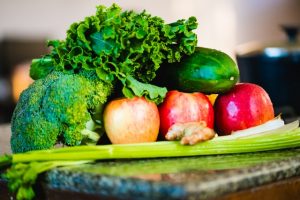I hope you and your loved ones are doing well – and are easily balancing this “new normal” (at least for now) lifestyle that’s been thrust on us by the coronavirus pandemic.
Better days are coming! But in the meantime, it’s still important to pay attention to our everyday wellness (beyond simply fighting to prevent the spread of the virus).
And that’s just one reason I’ve been talking so much about your gut this month. It’s tied in with almost every area of your health!
I’m bringing this up because for some people, eating a healthy meal can cause a lot of unwanted side effects.
Does this ever happen to you?
Maybe you make a beautiful salad loaded with fresh veggies, healthy fruits, and sprinkled with nuts and a homemade dressing.
And then an hour or so (or maybe even a day or so) later, your digestive system is in an uproar.
I’m talking about a bloated stomach, gas, a stomachache and maybe even an extra trip or two to the bathroom (or for some people, not enough bathroom visits).
Now, obviously if you’re having chronic issues you need to check with a doc to get to the bottom (no pun intended) of it all.
But a big cause for many people is a problem digesting fermentable oligosaccharides, disaccharides, monosaccharides, and polyols.
I realize that probably sounds like a foreigh language …
So I’ll break it down for you real quick!
They are called FODMAPs for short. FODMAPs are carbohydrates that your intestines have a hard time absorbing.
 As a result, they ferment right inside your body – and that leads to waste products that can cause gas, bloating, and sometimes pain.
As a result, they ferment right inside your body – and that leads to waste products that can cause gas, bloating, and sometimes pain.
Plus, FODMAPs draw liquid into your intestine, which can lead to diarrhea.
It’s not known exactly how many people have issues with FODMAPs, but it’s an issue that’s also linked with IBS, which affects 1 in 5 Australian’s within their lifetime.
Here’s the ironic part: some FODMAPs actually are prebiotics that are good for your gut!
The list of FODMAPs is long and includes everything from certain grains (wheat, rye, barley, etc.), some dairy products, legumes, and many fruits and veggies.
You can see a rundown here: www.healthline.com/nutrition/foods-high-in-fodmaps
Because these foods are good for us, it’s NOT recommended that most people cut them all out. Plus, because there are different types of carbs involved with FODMAPs, not every type might cause symptoms for you.
But figuring out exactly which foods are behind your issues can go a long way toward easing your symptoms.
One of the best ways to do this is to keep a food + symptom journal.
In it, you write down what you ate, and then any symptoms you are noticing afterwards. This will help you pinpoint any patterns.
Example: Over time you might notice you have issues after eating apples, garlic, mushrooms, or watermelon – all of which are high FODMAP foods.
You might also find that you can tolerate a certain amount of one of your trigger foods, or none at all! Or you might find out that after taking a break from it, you can tolerate that food again.
It’s a huge learning curve!
Like I said, it’s always important to talk about any digestive (or other!) issues with your doc or healthcare practitioner – and it’s also important before making big dietary changes.
But doing a little detective work can go a long way toward making informed choices.
And we are all about that!
The above process may seem like some random bunch of thoughts, but I’ve been there myself and followed this exact process over a 2-month period. Everyone will be different, I took is slow, just to be sure I was on the right track.
The end result? All those issues I mentioned above we completely gone.
If any of the above information sounds like I was talking directly to you, let me help you sort it out.
Andy
